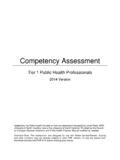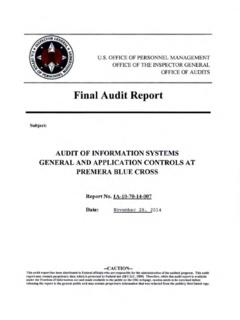Transcription of NIOSH List of Antineoplastic and Other Hazardous …
1 DEPARTMENT OF HEALTH AND HUMAN SERVICESC enters for Disease Control and PreventionNational Institute for Occupational Safety and HealthNIOSH List of Antineoplastic and Other Hazardous Drugs in Healthcare Settings, 2014 DEPARTMENT OF HEALTH AND HUMAN SERVICESC enters for Disease Control and PreventionNational Institute for Occupational Safety and HealthNIOSH List of Antineoplastic and Other Hazardous Drugs in Healthcare Settings, 2014ii1 This document is in the public domain and may be freely copied or reprintedDisclaimerMention of any company or product does not constitute endorsement by the National Institute for Occu-pational Safety and Health ( NIOSH ). In addition, citations of websites external to NIOSH do not constitute NIOSH endorsement of the sponsoring organizations or their programs or products.
2 Furthermore, NIOSH is not responsible for the content of these InformationTo receive documents or Other information about occupational safety and health topics, contact NIOSH atTelephone: 1 800 CDC INFO (1 8 0 0 232 4 63 6) TTY:1 888 232 6348 E-mail: visit the NIOSH website at a monthly update on news at NIOSH , subscribe to NIOSH eNews by visiting CitationNIOSH [ 2014 ]. NIOSH list of Antineoplastic and Other Hazardous drugs in healthcare settings 2014 . By Connor TH, MacKenzie BA, DeBord DG, Trout DB, O Callaghan Cincinnati, OH: Department of Health and Human Services, Centers for Disease Control and Prevention, National Institute for Occupa-tional Safety and Health, DHHS ( NIOSH ) Publication No.
3 2014 -138 (Supersedes 2012-150).DHHS ( NIOSH ) Publication Number 2014 -138 (Supersedes 2012-150) September 2014 Safer Healthier PeopleTMii1 Preamble:. The National Institute for Occupational Safety and Health ( NIOSH ) Alert: Preventing Occu-pational Exposures to Antineoplastic and Other Hazardous Drugs in Health Care Settings was published in September 2004, In Appendix A of the Alert, NIOSH iden-tified a sample list of major Hazardous drugs. The list was compiled from information provided by four institutions that had generated lists of Hazardous drugs for their respective institutions, as well as a list from the Pharmaceutical Research and Manufacturers of America (PhRMA).
4 The 2004 list was updated in 2010 and 2012. The current update ( 2014 ) adds 27 drugs and includes a review of the 2004 list and the consequent removal of 12 drugs that did not meet the NIOSH criteria for Hazardous drugs. In addition, a new format has been developed for the list of Hazardous drugs, as described below. The review process for the addition of the new listings is described in the Federal Register: Approach to Handling Hazardous DrugsIn the Alert ( NIOSH 2004) and updates to the haz-ardous drug list ( NIOSH 2012), NIOSH has recom-mended standard precautions or universal precau-tions be taken in handling Hazardous drugs. Given the addition of many non- Antineoplastic drugs and drugs in tablet and/or capsule form to the list, no single approach can cover the diverse potential occupational exposures to the drugs.
5 The current NIOSH approach involves three groups of drugs: Group 1: Antineoplastic drugs (AHFS Classifi-cation 10:00) [ASHP/AHFS DI 2013]. Note that many of these drugs may also pose a reproduc-tive risk for susceptible populations (Table 1). Group 2: Non- Antineoplastic drugs that meet one or more of the NIOSH criteria for a haz-ardous drug . Note that some of these drugs may also pose a reproductive risk for susceptible populations (Table 2). Group 3: Drugs that primarily pose a reproduc-tive risk to men and women who are actively trying to conceive and women who are pregnant or breast feeding, because some of these drugs may be present in breast milk (Table 3).
6 The majority of the reproductive risks associat-ed with the drugs listed in Table 3 are focused on women, but some can apply to men only (such as re-duced fertility or sperm count) or to both men and women. Although all Hazardous drugs should be handled accordingly, especially if they must be pre-pared aseptically, some populations of workers may not be at serious risk from handling drugs in Group 3. These include workers who are excluded from the susceptible populations for specific reasons such as age or infertility. In addition, drugs for which the manufacturer includes safe-handling guidance in the package insert are indicated.
7 NIOSH carries out a hazard identification on each drug on the basis of the NIOSH criteria for a Hazardous drug . No attempt has been made to perform risk assess-ments on each drug or to propose exposure limits. NIOSH has provided guidance for personal protec-tive equipment and ventilated engineering controls for some of the various scenarios in which a drug may be handled in health care settings (Table 5). This guidance cannot cover all possible situations but provides general recommendations for the ma-jor handling events typically seen in health Hazardous DrugsHazardous drugs include those used for cancer che-motherapy, antiviral drugs, hormones, some bioen-gineered drugs, and Other miscellaneous drugs.
8 The definition of Hazardous drugs used in the Alert is based on a definition originally developed in 1990 by the American Society of Hospital Pharmacists Appendix A Drugs Considered Hazardous23[ASHP 1990], currently known as the American Society of Health-System Pharmacists. Thus, the definition may not accurately reflect the potential toxicity criteria associated with some of the new-er-generation pharmaceuticals entering the health care setting. For example, bioengineered drugs tar-get specific sites in the body, and although they may or may not pose a risk to health care workers, some may pose a risk to and Other organizations are still gathering data on the potential toxicity and health effects relat-ed to highly potent drugs and bioengineered drugs.
9 Therefore, when working with any Hazardous drug , health care workers should follow the approaches described in Table 5, along with any recommen-dations included in the manufacturer s Safety Data Sheet (SDS).ASHP Definition of Hazardous DrugsASHP defines Hazardous drugs in its 1990 revision of the Technical Assistance Bulletin on Handling Hazardous Drugs [ASHP 1990]. The bulletin gives criteria for identifying potentially Hazardous drugs that should be handled in accordance with an es-tablished safety program [McDiarmid et al. 1991; Arrington and McDiarmid 1993; ASHP 2006; Mas-soomi et al. 2008; Eisenberg 2009; ONS 2011].
10 The criteria are prioritized to reflect the hierarchy of potential toxicity described below. Since the haz-ardous drugs covered by the Alert were designed as therapeutic agents for humans, human toxicity pro-files should be considered superior to any data from animal models or in vitro systems. Additional guid-ance for defining Hazardous drugs is available in the following sources: carcinogenicity [61 Fed Regist 17960 18011 (1996b); IARC 2014 ], teratogenicity [56 Fed Regist 63798 63826 (1991)], developmen-tal toxicity [56 Fed Regist 63798 63826 (1991)], and reproductive toxicity [61 Fed Regist 56274 56322 (1996a)]. Physical characteristics of the agents (such as liquid versus solid or water versus lipid solubility) also need to be considered in determining the po-tential for occupational Revision of ASHP DefinitionThe 1990 ASHP definition of Hazardous drugs* was revised by the NIOSH Working Group on Hazard-ous Drugs for the Alert.














